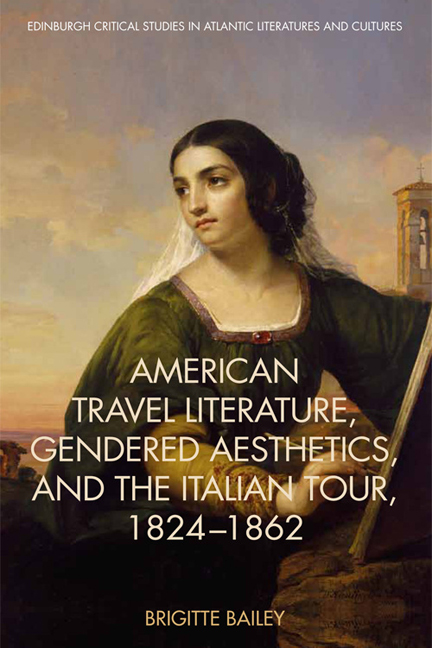Book contents
- Frontmatter
- Contents
- Illustrations
- Acknowledgments
- Introduction
- 1 Irving's Landscapes: Aesthetics, Visual Work, and the Tourist's Estate
- 2 The Protected Witness: Cooper, Cole, and the Male Tourist's Gaze
- 3 Gazing Women, Unstable Prospects: Sedgwick and Kirkland in the 1840s
- 4 Fuller and Revolutionary Rome: Republican and Urban Imaginaries
- 5 National Spaces, Catholic Icons, and Protestant Bodies: Instructing the Republican Subject in Hawthorne and Stowe
- Conclusion: Gender and Genre
- Notes
- Bibliography
- Index
Conclusion: Gender and Genre
Published online by Cambridge University Press: 10 May 2023
- Frontmatter
- Contents
- Illustrations
- Acknowledgments
- Introduction
- 1 Irving's Landscapes: Aesthetics, Visual Work, and the Tourist's Estate
- 2 The Protected Witness: Cooper, Cole, and the Male Tourist's Gaze
- 3 Gazing Women, Unstable Prospects: Sedgwick and Kirkland in the 1840s
- 4 Fuller and Revolutionary Rome: Republican and Urban Imaginaries
- 5 National Spaces, Catholic Icons, and Protestant Bodies: Instructing the Republican Subject in Hawthorne and Stowe
- Conclusion: Gender and Genre
- Notes
- Bibliography
- Index
Summary
Friday, Christmas Day [1857]. Went to Boston at seven, ‘twas bitter cold… . Went to the Fair, and saw many beautiful articles; the most beautiful was a set of photographs of the different ruins of Rome executed by Mrs. Jam[i]eson's son-in-law and sent by her from Rome to the Bazaar. The explanations were written by her and accompanied by her autograph.
Charlotte Forten GrimkéAs the twenty-year-old Charlotte Forten describes her visit to the annual Boston Anti-Slavery Fair, she highlights two experiences: seeing some of the famous men associated with the movement (Wendell Phillips, Charles Sumner, and Ralph Waldo Emerson – “it was glorious to see such a trio” [274]) and seeing the items on sale at the fund-raising Bazaar. Of the “many beautiful articles” contributed by supporters of abolition she singles out a cluster of tourist materials, a package sent by a famous British writer on travel, art, and aesthetic perception: Anna Jameson, author of The Diary of an Ennuyée and books on literature, women's work, and Italian art. The photos she includes are by Robert Macpherson, who in 1857 was at the peak of his popularity as the expatriate Scottish photographer of Roman ruins, buildings, and landscapes. In subsequent years photographs would quickly become a familiar part of the ritual of tourism; post-Civil War tourists in Rome bought unbound copies of Hawthorne's Marble Faun and personalized them by having them bound with their own selections of photos of famous sites, sites described in the romance. But at this moment Macpherson's photos were new, “exquisite” (274), and even startling. Jameson's “explanations” of the sites her niece's husband (not her son-in-law, as Forten supposes) had photographed added value because of her status as an art historian and as the author of a popular fictionalized travel book which combined aesthetic perception with emotional response. The buyer would have received classic views of the major tourist sites of Rome in a cutting-edge medium by an innovative photographer and an informed commentary that mediated the visual impact of the pictures; in addition, the signature of a celebrity, in the autograph-hungry culture of the period, would have lent a personal connection and (unlike the photos) a singular, unreproducible, and authentic touch to the cluster.
- Type
- Chapter
- Information
- Publisher: Edinburgh University PressPrint publication year: 2018

